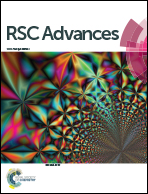First synthesis of novel 2,4-bis((E)-styryl)quinoline-3-carboxylate derivatives and their antitumor activity†
Abstract
A simple and flexible synthesis of a new series of 2,4-bis((E)-styryl)quinoline-3-carboxylates (3a–t) has been achieved for the first time in good yields via successive Arbuzov/Horner–Wadsworth–Emmons (HWE) reaction in one-pot using the newly-synthesized ethyl 4-(bromomethyl)-2-(chloromethyl)quinoline-3-carboxylate as the substrate. Our synthetic protocol is as attractive and powerful as it is simple, tolerates a wide range of substituents, and does not involve the use of expensive reagents or catalysts. These title compounds belong to a new class of quinoline derivatives and their antitumor activity was assessed on human cancer cell lines (A549, HT29 and T24). The MTT assay showed compounds 3h, 3k and 3t had significant inhibitory activity with IC50 values of 1.53, 1.38 and 2.36 μM against A549 and 1.50, 0.77 and 0.97 μM against HT29, respectively, much better than the reference cisplatin.



 Please wait while we load your content...
Please wait while we load your content...